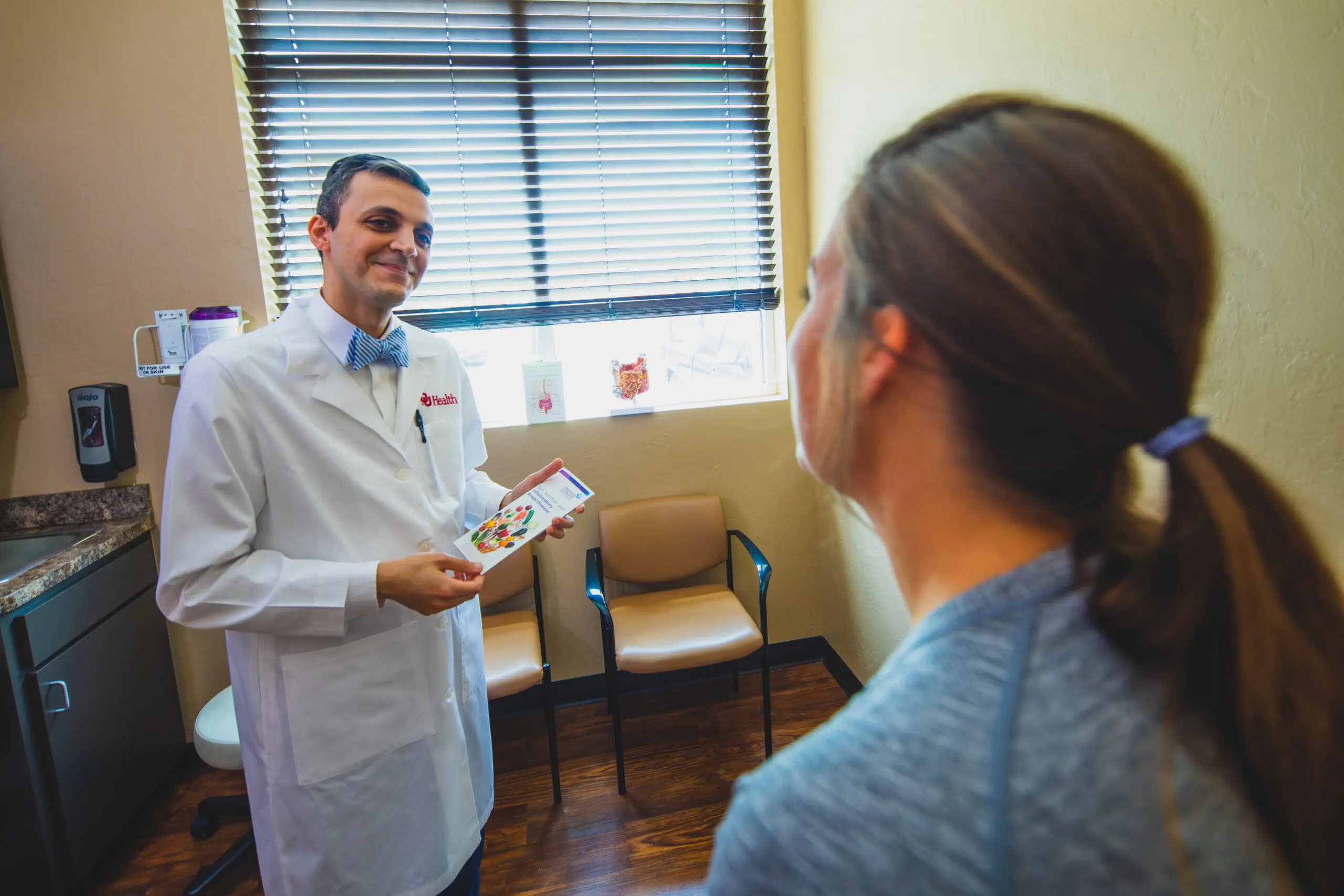Reaching Fitness Goals
Kicking off the new year is often marked by fitness and weight loss goals. Offering helpful reminders on how to lose weight and keep it off, Kathryn Reilly, MD, a family practice physician with OU Health Physicians, shares the following advice.
“For consistent weight loss it’s important to have a plan,” she says. “Understand what common portion sizes are, limit eating out, limit drinking any liquids that include calories (it has been shown that when you drink calories the body often does not recognize it as food), and carve a regular time to get exercise.”
If intermittent fasting or restricting specific types of food appeals to you, Reilly recommends doing your research and learning how those food plans are carried out.
“If results aren’t happening, writing down everything that is eaten and drunk over several days can provide insight into what the problems are – not just the food itself but the quantity,” she says.
She also suggests mixing up your fitness routine as well as watching out for hidden calories.
“The biggest hidden calories are in drinks – fancy coffee drinks, soda with calories, sweet tea, mixed drinks and beer,” she says. “Again, portion size is critical. If one is eating cheese and crackers as a snack, look at the package and see what a portion is. Many packages that appear to be a single portion actually hold two or more portions. Eating on a salad plate, planning for half the plate to be vegetables, and avoiding high calorie sauces or salad dressings on the vegetables can all help cut calories.”
Once you’ve attained your goal weight, it’s important to weigh at least once a week to monitor any weight gain.
“Most people can lose weight but few keep it off,” says Reilly. “If the weight is up four to five pounds, go back to the plan for a week or two.”
Some people include a binge in their diet plan, says Reilly, either once a week or twice a month.
“One thing that can lead to failure in diet plans is getting discouraged about an unexpected binge or a week in which no exercise is done,” she says. “It’s important to get back on the plan and recognize ways to avoid such lapses in the future.”
It’s also helpful to avoid trigger foods, if possible, at home or at the office.
“If sweets or ice cream are a big temptation, don’t make it easy to succumb,” says Reilly. “If it’s not easily grabbed, your brain may be able accept a less caloric substitute.”

Photo courtesy John Jackson
Targeting Problem Areas
John Jackson, a personal trainer and the owner of Impact Fitness in Tulsa, says targeting a specific area of the body is still about overall fitness and strength training.
“As a personal trainer, if someone is looking to spot reduce and enhance their body, we have to break down a few factors including medical history, gender, age, nutrition, hormonal status and physical activity,” he says. “Each person has a specific body composition and it has to be taken into consideration when planning an exercise program that will complement their fitness goals.”
For general fitness or spot reduction, Jackson suggests multi-joint movements.
“These movements incorporate more than one joint of activation per exercise,” he says. “Overhead press, squats and lunges with a bicep curl are a few multi-joint movements that are beneficial for overall fitness and conditioning. As it pertains to strength days versus cardio days, it depends on the person and their physical fitness needs. For example, a triathlete will need to work more on endurance training and strength training to help stabilize endurance for competition. Conversely, for a person that just wants to maintain tone and be in reasonable shape, you would look at a more balanced training regimen of weights two to three times a week and cardio every other day for body maintenance.”
However, despite one’s efforts through diet and exercise, there can still be those hard-to-budge spots. One alternative to reach those areas is a new, noninvasive fat-freezing system, CoolSculpting Elite.
“This revolutionary new fat-freezing system is FDA-cleared to treat nine different areas of the body, including under the chin and jawline, upper arms, abdomen, love handles and thighs,” says Melody Hawkins, chief financial officer with BA Med Spa and Weight Loss Center in Broken Arrow. “It has been reimagined with dual applicators to treat two places at once, giving it the power to treat twice the fat in half the time.”
Hawkins says CoolSculpting Elite is a great option for any adult and fits into even the busiest of lifestyles.
“You can come in and have your treatments done, drive yourself home, continue on with your complete normal routine, and begin seeing results in three weeks,” she says. “One treatment will permanently eliminate 20 to 25 percent of fat in the targeted area.”

What is Mindfulness?
To understand the purpose and benefits of mindfulness, Rebecca Brumm, MA, LPC, CEDS, the director of operations for the Laureate Eating Disorders Program at Laureate Psychiatric Clinic and Hospital in Tulsa, shares a few ways in which being more mindful can enrich your life.
“Mindfulness is being fully present in what you’re doing, your surroundings and what’s truly happening in the moment. It’s such an amazing tool,” she says. “It’s simple but not easy. It’s challenging because we’re so often somewhere else in our minds.”
She says our brains are so good at learning processes and automating processes that we don’t use a hundred percent of our brain capacity as we live our lives.
“What happens is our brains get good at making a habit out of what we do often so we don’t have to think about it to do it – while we can be physically present in great, joyful moments … mentally we are still experiencing the stress of a work deadline, or fear about a parent’s illness,” she says. “Mindfulness is really about being where you are.”
Mindfulness Exercises
Research has shown that practicing mindfulness for as little as five or 10 minutes a day can be effective.
Brumm says mindfulness exercises are an opportunity to “train ourselves to reconnect to the present moment and stop the endless cycle of thought after thought. It’s when we remind ourselves to look at our child’s face or acknowledge the experience of holding a partner’s hand.”
To help incorporate mindfulness into your daily routine, Brumm suggests choosing a regular activity but committing to doing it mindfully.
“For instance, brushing your teeth. When I brush my teeth I try to observe with my senses – I notice the taste of the toothpaste, the smell, the sensation of the toothbrush on my teeth, what I see …I fully absorb the experience,” she says. “For someone else it might be washing the dishes or sitting down and drinking their morning coffee. Even one minute of deep breathing will recenter you.”

The Benefits
“There are mental and physical benefits of mindfulness,” says Brumm. “Some of the physical benefits include reduced blood pressure and more therapeutic resting breath, which naturally leads to mental benefits such as reduced anxiety, a deeper feeling of gratitude and contentment, and less depression.”
She says anxiety and depression causes us to live outside of the moment.
“We are thinking about our fears and about what’s to come or what has happened in the past,” she says.
She says mindfulness can help us recognize the different kinds of thoughts or narratives that we think about and that influence our decisions. Mindfulness is a way to quiet those ‘voices’ and make sure that what we say to ourselves internally aligns with our values and goals.






















